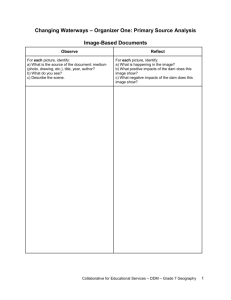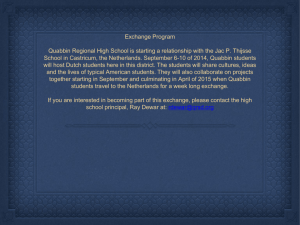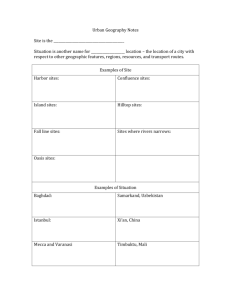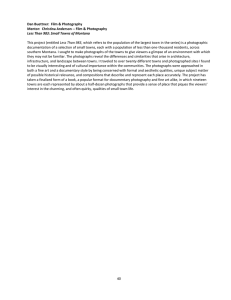Document 13549136
advertisement
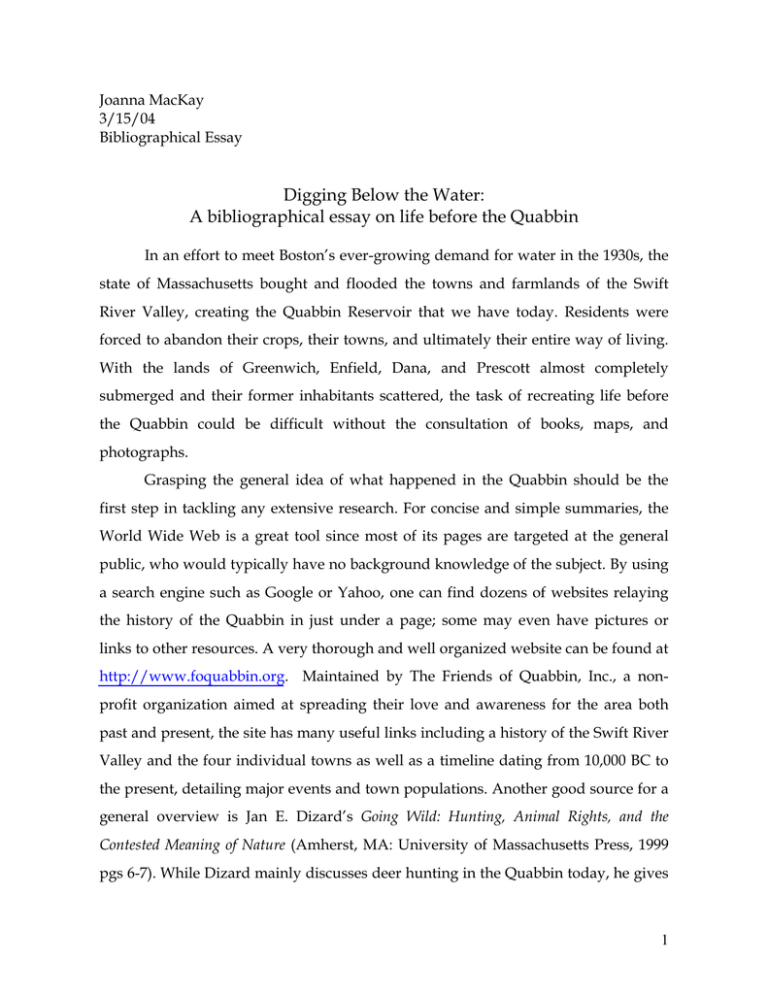
Joanna MacKay 3/15/04 Bibliographical Essay Digging Below the Water: A bibliographical essay on life before the Quabbin In an effort to meet Boston’s ever-growing demand for water in the 1930s, the state of Massachusetts bought and flooded the towns and farmlands of the Swift River Valley, creating the Quabbin Reservoir that we have today. Residents were forced to abandon their crops, their towns, and ultimately their entire way of living. With the lands of Greenwich, Enfield, Dana, and Prescott almost completely submerged and their former inhabitants scattered, the task of recreating life before the Quabbin could be difficult without the consultation of books, maps, and photographs. Grasping the general idea of what happened in the Quabbin should be the first step in tackling any extensive research. For concise and simple summaries, the World Wide Web is a great tool since most of its pages are targeted at the general public, who would typically have no background knowledge of the subject. By using a search engine such as Google or Yahoo, one can find dozens of websites relaying the history of the Quabbin in just under a page; some may even have pictures or links to other resources. A very thorough and well organized website can be found at http://www.foquabbin.org. Maintained by The Friends of Quabbin, Inc., a nonprofit organization aimed at spreading their love and awareness for the area both past and present, the site has many useful links including a history of the Swift River Valley and the four individual towns as well as a timeline dating from 10,000 BC to the present, detailing major events and town populations. Another good source for a general overview is Jan E. Dizard’s Going Wild: Hunting, Animal Rights, and the Contested Meaning of Nature (Amherst, MA: University of Massachusetts Press, 1999 pgs 6-7). While Dizard mainly discusses deer hunting in the Quabbin today, he gives 1 a brief, clear history of the area in two pages, detailing the process of choosing the site of the reservoir as well as the need for careful clearing of the land. With at least a partial understanding of the issues involved in creating the Quabbin reservoir, one can research the topic in depth more effectively. Detailed, factual histories of the Quabbin Reservoir lay out the major events chronologically, often serving as primary sources of the brief generalizations found online, for example. A great detailed account is J.R. Greene’s Creation of Quabbin Reservoir: Death of Swift River Valley (Athol, MA: JR Greene, 1987), which covers everything from the growth of the town to the construction’s aftereffects on agriculture. J.R. Greene proves to be one of the main historians of the Quabbin, having been researching the topic since 1975, publishing books, history calendars, and atlases. In this book, he very clearly explains the causes of the growth and eventual decline of farming in the Swift River Valley in particular and then proceeds to detail the politics of obtaining the land needed to build the reservoir as well as the residents’ legal struggles against it. A great feature of Greene’s chapter on the “exodus” (pgs 66-73) is his ability to emphasize the slowness of the moving process. While other historians deal with the issue swiftly, Greene details the long drawn out, last few months of the four towns’ existences, in which life seemed to slowly crawl to a halt as construction of the dams began. Greene also includes various pictures as well as a table in which the decline in population of each of the towns can be visualized. Another good history is Thomas Conuel’s Quabbin: The Accidental Wilderness (Amherst, MA: University of Massachusetts Press, 1990), a sympathetic but factual account of the towns that once existed and the reservoir that inevitably took their place. Conuel provides a good general overview of the history of the region, but also details the wildlife that have made it their home today, focusing not only on the beauty of the past, but also on the beauty of the present. Quabbin: The Accidental Wilderness has some great photographs, that most books lack, portraying the process of preparing the lands for flooding, including the moving of houses and 2 the destruction of bridges. These books contain the most relevant facts of the Quabbin’s history in an organized and efficient manner. By giving a fairly objective view resistant to change, maps aid in the visualization and understanding of facts as well as serve as a good basis for comparison across time periods. Often a writer tries to describe what only a map can display, such as the spatial arrangements of towns and bodies of water. In the context of the Quabbin Reservoir, they give a sense of size to the towns that were lost and the reservoir that was made, as well as show the stage of settlement and development in a certain year by the number of roads and where they intersected. The main source for maps of the pre-reservoir towns is J.R. Greene’s An Atlas of the Quabbin Valley and Ware River Diversion (Athol, MA: J&P Printing Co., 1996). Greene provides a pagesize road map for each of the four towns: Greenwich, Enfield, Dana, and Prescott, as well as for other parts of towns like Millington that were also destroyed. Along with the maps, he also includes brief histories for each of the towns, including information such as population size and date created. Such maps of non-existent towns are hard to come by. Another useful map is the “Plan of Proposed Reservoir on the Swift River and Its Tributary Watershed” (Belchertown, MA: Friends of Quabbin Inc., 1922, redrawn by D. Chandler, 1986). This large map shows the towns, roads, and cemeteries in detail that would soon be replaced by the Quabbin Reservoir. While obtaining the facts is crucial, gaining a sense or feeling of life in the Swift River Valley is also important. The everyday life of the everyday resident is not mentioned in most histories. Such details can be easily overlooked or hidden by numbers and generalizations, but it is these “useless” details that can bring the past to life. Through his book The Day Four Quabbin Towns Died (Athol, MA: Transcript Press, 1985), J. R. Greene is able to recreate the last few days of life in the valley through documents such as local newspapers. His descriptions are very specific, allowing the reader to understand what a day in the life of a resident would be like. By including the names of actual inhabitants in their daily activities as well as dates and times, he gives every minor detail importance. Besides the initial introduction 3 and history, Greene does not offer much opinion or explanation, but instead simply narrates events such as the last day celebrations. At the end he includes a list of residents of the four towns as well as copies of two laws passed regarding the area’s existence. Another source for ordinary details of the Swift River Valley often missed, though based on experience and not documents, is Evelina Gustafson’s Ghost Towns ‘Neath Quabbin Reservoir (Boston, MA: Amity Press, 1940). A travelogue from her two trips through the valley in 1938 and 1939, Gustafson’s book reads like a tour, directed towards the reader. As she drives through each town pointing out buildings and important roads, Gustafson gives brief histories and anecdotes of each, just as a tour guide would. Set after the official closing of the towns, her account is sentimental towards the people who were then forced to pack up and leave. She also focuses on an event not covered by most historians: the auctions in which some residents sold everything they could not move, while others bid, hoping to save their memories and retain a piece of their past. Such memories cannot be described by mere facts and figures. Visual imagery provides details that are sometimes lost in words. A good source for all kinds of photographs relating to the Quabbin Reservoir and its history is Joseph W. M. Russell’s A Quabbin Chronicle: 1900-1988 (Monson, MA: Blatchley’s Printers, 1988). Organized chronologically, pictures of buildings, people, newspaper clippings, and documents give insight into how the Swift River Valley changed over the years. Russell covers everything from the hurricane of 1936 to the last post office mailings of 1938 to the reunions of former residents in the 1980s. He also includes a hydrogaph of floods and a chart detailing the readjustment of towns after the reservoir’s creation. A great collection of photos of Greenwich, Enfield, Dana, Prescott, and New Salem and their former inhabitants can be found in Elizabeth Pierce’s Images of America: The Lost Towns of the Quabbin Valley (SC: Arcadia Publishing, 2003). Separated into chapters by town, black and white photographs of residents, homes, stores, and road signs, when pieced together, give almost a complete image of the Swift River Valley before the threat of its destruction. For 4 photographs of buildings in their original and present locations, Joseph W.M. Russell’s Vestiges of the Lost Valley: Buildings and Bells from the Quabbin (Monson, MA: Blatchley’s Printers, 1986) is the perfect source. Before the Swift River Valley was filled with water, its buildings were relocated to nearby towns. Russell compiled pictures of these houses, churches, and stores both where they were originally built and where they reside today. Interestingly, he also includes various church bells that were moved, in particular a bell that was melted down and re-formed into many miniature ones. Since many of the former residents of the Swift River Valley are alive today, their memories and sentiments can be important in evaluating the impact the Quabbin Reservoir had on their lives. Quabbin Voices is a quarterly publication from The Friends of the Quabbin, Inc., in which former residents can share their stories, poetry, and pictures with one another as well as the rest of the world. It is within these pages that they hope to keep the past of the lost towns alive. The newsletter can be found at The Friends of the Quabbin homepage at http://www.foquabbin.org. A source for more sources is always helpful when conducting extensive research. J.R. Greene’s A Bibliography of Quabbin Valley History (Athol, MA: Transcript Press, 1992) contains a broad list of materials relating to the Quabbin Reservoir and the Swift River Valley. Organizing his resources first into sections such as books, journals, government documents, or theses, and then alphabetically by author, Greene reduces the workload for future researchers. Under many of the titles, he even explains their pros and cons as sources of information. The towns of the Swift River Valley are gone forever, but they have left many stories and artifacts behind. Through careful research and investigation, the past can be recreated and perhaps better understood. Buildings and forests were destroyed but as with any destruction, there is also creation. The Quabbin Reservoir has become a vital source of life not only for the people of Boston, but also for the plants and animals that have made the area their home. 5 Annotated Bibliography Chandler, D. 1986 [1992].“Plan of Proposed Reservoir on the Swift River and Its Tributary Watershed”. Belchertown, MA: Friends of Quabbin Inc. - It is a very large map of the proposed reservoir detailing Greenwich, Prescott, Dana, and Enfield as well as the surrounding towns. It shows the locations of rivers, ponds, cemeteries, and boundary lines and also outlines where the reservoir will be. Compared to other small maps in books, this map is easy to read because of its size. Conuel, Thomas. 1990. Quabbin: The Accidental Wilderness. Amherst, MA: University of Massachusetts Press. - This is a good detailed history of the Swift River Valley. Conuel is sympathetic for the lost past, but also appreciative of the reservoir and its wildlife today. It has great photographs, including ones depicting the moving process and a clear explanation of the choice to create the reservoir in the first place. Dizard, Jan E. 1999. Going Wild: Hunting, Animal Rights, and the Contested Meaning of Nature. Amherst, MA: University of Massachusetts Press. - This book focuses mostly on the issue of deer hunting in the Quabbin park, but in the first few pages it gives a good overview of the Quabbin’s history in a concise and well-organized manner. It is a good resource with which to gain some simple background knowledge on the subject. Greene, J. R. 1996. An Atlas of the Quabbin Valley and Ware River Diversion. Athol, MA: J&P Printing Co. - This atlas contains detailed road maps of the towns in the Swift River Valley as well as town histories. These maps are hard to come by since the towns no longer exist. - - - 1992. A Bibliography of Quabbin Valley History. Athol, MA: Transcript Press. - This is Greene’s collection of resources from all of the research that he has done. He lists books, journals, newspapers, magazines, theses and government documents that deal with the Quabbin’s history. He organizes the bibliography first by type of material and then alphabetically by author. For the books he provides notes on what they contain. - - - 1987. Creation of Quabbin Reservoir: Death of Swift River Valley. Athol, MA: JR Greene. - It is a well-explained history of the Quabbin, covering the politics as well as the last days of the towns. Greene does a great job depicting the slowness of 6 the moving process. He includes pictures of the towns and the dams, as well as a table showing the changes in population. - - - 1985. The Day Four Quabbin Towns Died. Athol, MA: Transcript Press. - This book gives a general feeling of the towns in their last days as opposed to just facts. It reads like a narration, involving the names of residents as well as specific times and dates. Greene includes of lists of residents of the four towns and two laws pertaining to the area’s existence. Gustafson, Evelina. 1940. Ghost Towns ‘Neath Quabbin Reservoir. Boston, MA: Amity Press. - This is a travelogue of the author’s trips through the Swift River Valley. It reads as a tour with the author as the tour guide, pointing out interesting sites and giving bits of history. It is very sentimental and gives the reader a vivid picture of life before the Quabbin. Pierce, Elizabeth. 2003. Images of America: The Lost Towns of the Quabbin Valley. SC: Arcadia Publishing. - This is a great collection of photographs of the people, buildings, and signs of the Swift River Valley towns. The pictures are organized by town and introduce the former residents of the area. Russell, Joseph W. M. 1988. A Quabbin Chronicle: 1900-1988. Monson, MA: Blatchley’s Printers. - A pictoral record of the Quabbin, this book has everything from photographs of the towns to newspaper clippings, and even the last graduation notices. It is organized chronologically and covers the area’s whole history. This book probably contains the best visual imagery on the subject. - - - 1986. Vestiges of the Lost Valley: Buildings and Bells from the Quabbin. Monson, MA: Blatchley’s Printers. - This book contains pictures of many of the buildings that were moved to make way for the reservoir. It shows the original locations of houses, stores, and churches beside their current locations in nearby towns. Russell also includes church bells that were relocated. http://www.foquabbin.org -A website run by The Friends of Quabbin, Inc. It has a well-written, but brief history of the Quabbin area as well as histories of the four towns, making it a good general overview of the topic. Includes a detailed timeline in the section “Chronology” dating back to 10,000 BC. Provides access to the Quabbin Visions newsletter in which former residents share their stories and pictures. 7 MIT OpenCourseWare http://ocw.mit.edu 21H.421 Introduction to Environmental History Spring 2011 For information about citing these materials or our Terms of Use, visit: http://ocw.mit.edu/terms.
